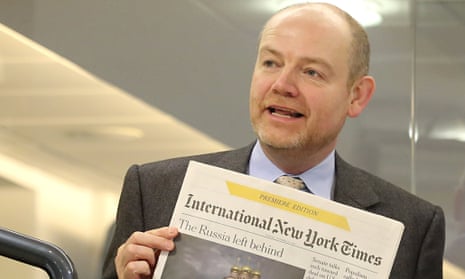Mark Thompson, former director general of the BBC, became chief executive officer at the New York Times because the ruling Sulzberger dynasty thought he understood the digital world: an iPlayer as well as a team player. And, indeed, his Times has taken the online road, commissioning learned reports on change, launching apps, building ingenious paywalls and, only a few days ago, agreeing that its solemn news conference wouldn’t talk print front-page contenders any more. Hear the march of “digital first”. But also catch up with Thompson at a recent conference gig. “I think the profitability of print is going to be part of the economics for many years to come. The actual demand from readers has not declined anything like the demand from print advertisers.”
All of which illustrates one perpetual difficulty in charting media futures – including Guardian and Observer futures as the declared in-house candidates to become editor-in-chief wrestle with the problems of what they chiefly expect to edit: a global digital news empire, a daily printed paper, a Sunday, perhaps a big print weekend, perhaps some dissemination combination that has yet to be invented?
Digital first has developed wider resonances over the years. In the beginning, it used to mean that, when you had a story or feature ready to go for the next day’s print edition, you slapped it up on the web pronto. Today, amid myriad algorithms, a more complex approach involves maximising unique visitings, clicks, dwell times et al to extract the biggest digital bang for advertising bucks. A 24/7 voyage of discovery. And the poor old print paper, hanging in there? Irritatingly, as Thompson says, residual readers still seem to like it. Irritatingly, not every new wheeze – in the case of the New York Times, a much-touted News Lite app – wins approval. Irritatingly, too, ad rates for print remain far more lucrative than they do online. How do you encapsulate so much tech theology in simple, inevitably simplistic terms? Think Yo Sushi! Umpteen little plates of noodles, rice, smoked fish and meat move endlessly along a belt on a restaurant counter. Diners pick up what they fancy as it passes by. Cooks can see what’s selling and prepare more. Everyone’s happy – unless, that is, you occasionally want to sit down to a complete menu of something entirely different, something pre-pondered and savoured.
And it’s here, one tempura prawn over a load, that the problems start. For Yo Digital! is a different beast, just as (to keep the kitchen comparisons rolling) Masterchef contestants inventing something edible from sweetbreads, turnips and soya sauce rather than producing a classic daube are playing a different game. Moving into media, moreover, the BBC 24-hour news channel isn’t the six o’clock bulletin. One is fast and flexible; the other calm, considered, a bit stolid. But, from sashimi to Fiona Bruce, the same intrinsic question is posed: Do you want reasonable, ordered but interim conclusions on the news menu – or do you want to try to make sense of everything for yourself, pulling plates from the moving belt of life?
It’s entirely permissible to answer: both. That’s what Thompson is doing as one speech vies with another. That’s what some Guardian challengers are doing when they press the pending advantages of a continuing print Saturday and print Sunday (which, because they are more conventionally commissioned and edited, can’t be purely digital first). But never forget the cash factor in all such churn.
Mere numbers with fantastic dwell times don’t seal a real deal. YouTube, we learned again last week, has 1 billion viewers and no profit. The Daily Mail online is closing in on 200 million unique browsers a month, but has only just got over the £60m ad revenue mark (with a long way to go before real profits start rolling in). Last week’s national readership survey showed print reading falling and mobile use booming yet again.
But newspapers still reach 93% of UK adults one way or another: and some 20m from that total pick up a paper on the mat or from a newsagent’s counter each day. Overall, every month, twice as many readers reach for a paper as catch the news on their mobile. Some papers – say the Guardian or the Telegraph – have found ways to reverse those proportions completely. But others – say, the London Times or the Sun – score print figures 10 times or more above mobile take-up.
So the pace and nature of change vary hugely. A digital paywall firmly in place on an upmarket paper might bring in well over £20m a year (money flowing before you add ad revenue and the rest). Bolt in broadly the same for print-only subscriptions plus the rewards – currently perhaps three times digital – from ordinary, one-off purchase and the case for walls looks rather more open and somewhat less shut. It’s one part of one possible answer. If advertising has to bear all of the strain, you can understand why Thompson is a touch circumspect – especially after a slightly sluggish digital ad start to the new year.
Of course, the odds are weighted against print. It’s a heavy-duty physical product in a new age. It lacks the excitement of high-tech revolution. It’s expensive, often because it has to cover digital development costs. It is the work of editors solemnly weighing one story against another, deciding what leads the New York Times this morning: fair game for blog derision.
But Thompson poses the problem starkly. Residual readers in their millions still want what it offers. Do you choke them off, raising prices, cutting distribution, filling your pages with sushi? Or do you, as the New York Times is doing, place a side bet on upgraded magazines and print supplements? If the answer for now, however unwelcome to finance controllers scratching their heads, is “both”, then where’s the infrastructure, intellectual and physical, that keeps both engines running? Yo-ho-hum …

